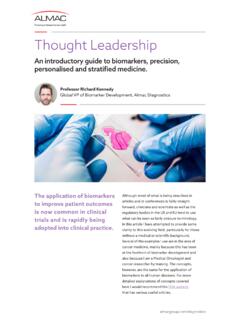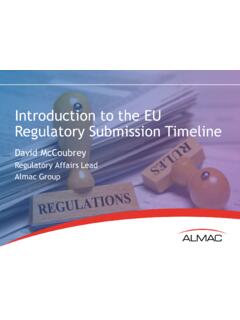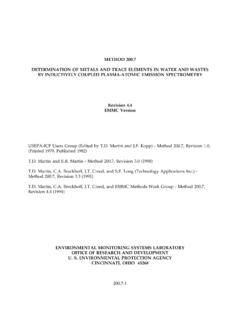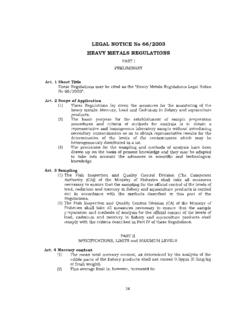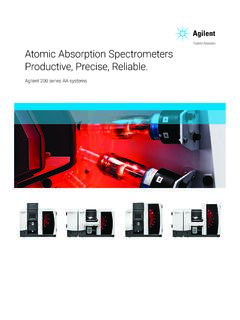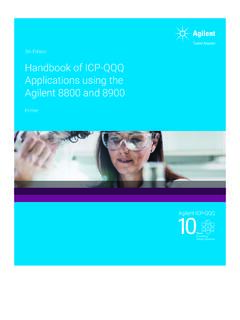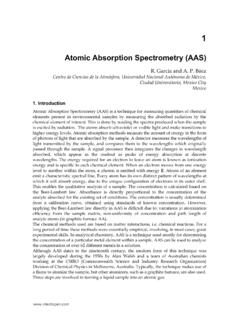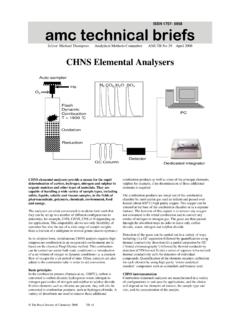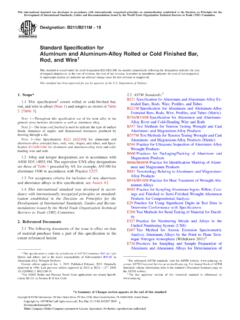Transcription of Journal of Pharmaceutical and Biomedical Analysis
1 Journal of Pharmaceutical and Biomedical Analysis 145 (2017) 84 90 Contents lists available atScienceDirectJournal of Pharmaceutical and Biomedical Analysisjournal and validation of an ICP-MS method for thedetermination of elemental impurities in TP-6076 activepharmaceutical ingredient (API) according to USP 232 / 233 Osama Chahroura, , John Malonea, Mark Collinsa, Vrushali Salmona, Catherine Greenana,Amy Bombardierb, Zhongze Mab, Nick DunwoodybaAlmac House, 20 Seagoe Industrial Estate, Craigavon, BT63 5QD, UKbTetraphase, 480 Arsenal Way, Ste #110, Watertown, MA 02472, United States of Americaa r t i c l e i n f oArticle history:Received 4 April 2017 Received in revised form 13 June 2017 Accepted 17 June 2017 Available online 20 June 2017a b s t r a c tThe new guidelines of the United States pharmacopeia (USP), European pharmacopeia (EP) and inter-national conference on harmonization (ICH) regulating elemental impurities limits in pharmaceuticalssignify the end of unspecific Analysis of metals as outlined in USP 231.
2 The new guidelines specify bothdaily doses and concentration/limits of elemental impurities in Pharmaceutical final products, activepharmaceutical ingredients (API) and excipients. In chapter USP 233 method implementation, validationand quality control during the analytical process are described. We herein report the use of a stabilisingmatrix that overcomes low spike recovery problem encountered with Os and allows the determination ofall USP required elemental impurities (As, Cd, Hg, Pb, V, Cr, Ni, Mo, Cu, Pt, Pd, Ru, Rh, Os and Ir) in a singleanalysis. The matrix was used in the validation of a method to determine elemental impurities in TP-6076 active Pharmaceutical ingredient (API) by ICP-MS according to the procedures defined in USP 233 and to GMP requirements.
3 This validation will support the regulatory submission of TP-6076 which is anovel tetracycline analogue effective against the most urgent multidrug-resistant gram-negative bacte-ria. Evaluation of TP-6076 in IND-enabling toxicology studies has led to the initiation of a phase 1 clinicaltrial. 2017 Elsevier All rights IntroductionThe current United States pharmacopeia (USP) method formonitoring inorganic contaminants in Pharmaceutical samples asdefined in general chapter 231 is over a 100 year-old colorimet-ric test. This method, known as the heavy metals limit test , isbased on precipitation of 10 sulfide-forming elements (Ag, As, Bi,Cd, Cu, Hg, Mo, Pb, Sb and Sn), in a reaction with a reagent such asthioacetamide [1].
4 The resulting coloured precipitate is comparedvisually to a 10 g/g Pb standard to determine compliance with theheavy metal limit. Besides the obvious potential variability associ-ated with a subjective visual comparison, USP 231 is a limit testbased on the sum of the 10 elements , and so does not give indi-vidual concentrations for each element. The current USP method, 231 heavy metals limit test , is acknowledged to be inadequateand is due to be replaced with new general chapters USP 232 (lim- Corresponding address: (O. Chahrour).its) and 233 (procedures) which are currently official and due tobe enforced in 2018. Similar regulations were also issued by theEuropean pharmacopeia (EP) and international conference on har-monization (ICH) regarding the limitation of elemental impurities,such as heavy metals and catalyst residues, produce an urgent needfor robust and efficient ICP-MS analytical methods [2 6].
5 USP 232 defines permitted daily exposure (PDE) limits for awide range of inorganic (elemental) impurities: As, Cd, Hg, Pb, V,Cr, Ni, Mo, Cu, Pt, Pd, Ru, Rh, Os and Ir. The daily exposure lim-its must be scaled for the recommended maximum daily dose ofthe drug under investigation, so for a product with a daily dose of10 g, the elemental impurity level in the dosage form (measured in g/g) must be 10 times lower than the limits shown. The requiredlimits can easily be measured directly with modern instrumentaltechniques such as ICP-MS referenced in USP 233 [7,8].However, many drug products/substances will require aciddigestion with its associated dilution of the original sample toobtain solutions suitable for ICP-MS Analysis .
6 This represents a chal-lenge as the digestion process is material consuming and manynovel drugs are based on increasingly sophisticated and 2017 Elsevier All rights Chahrour et al. / Journal of Pharmaceutical and Biomedical Analysis 145 (2017) 84 90 85 Table 1 Actual elemental impurities target limitsain TP-6076 active Pharmaceutical ingredi-ent amended for the maximum daily dose and the expected elemental contaminantsin the Concentrationlimits ( g/g) forparenteral drugproducts with amaximum dailydose of 10 g/daydaily dose ofinjection <100 mLConcentrationlimits ( g/g) forparenteral drugproducts with amaximum dailydose of g/daydaily dose ofinjection <100 mLActual targetlimit( g/g)
7 Cd 5 10 5As 3 3 1 20 10Os 1 20 10Pd 1 20 10Pt 1 20 10Rh 1 20 10Ru 1 20 10Cr Not a safety concern Not a safety concern 100Mo 1 20 10Ni 5 100 50V 1 20 10Cu 10 200 100aLimits are as per USP232 and official from February 1, 2013 till December 1, Pharmaceutical ingredients (APIs), which may only be avail-able in very small amounts [9 12]. The dilution associated withthe preparation of these milligram-scale sample weights meansthat careful consideration needs to be given to the experimentaldesign to minimise errors. Also, the digestion sample prepara-tion approach is based on the complete break-down of the samplematrix often by oxidising mineral acids which will cause problemsin the determination of osmium traces, since this element formsdifferent species of varying volatility under such conditions, lead-ing to uncontrolled losses of Os [13,14].
8 Although Os is frequentlystabilised by the addition of chloride or HCl, it can still be present asvarious species in different oxidation states and chemical compo-sition in hydrochloric matrices leading to significant losses of theanalyte during storage or sample preparation [15]. A recent studyon the topic demonstrates that the accurate quantification of totalOs concentrations together with all elements required by the USPchapter 232 following oxidative digestion is difficult and prone toerrors [16].We herein report the use of a mixture to stabilise Os in an oxi-dizing environment by using an aqueous solution of 5% HCl (v/v), acetic acid (v/v), thiourea (w/v) and ascorbicacid (w/v).
9 This digestion free approach has been applied in thepresent study and showed the capability to analyse the full rangeof elements as required by the USP using one simple dissolutionprocess/method. The approach was used in the determination ofCd, Pb, As, Hg, Ir, Os, Pd, Pt, Rh, Ru, Cr, Mo, Ni, V, and Cu con-tent in TP-6076 active Pharmaceutical ingredient (API) by ICP-MSaccording to the validation procedures defined in USP 233 . The ele-mental impurities limits are based on the maximum daily dose andthe expected elemental contaminants in the excipients used; theseare listed in Table 1. This validation will support the regulatorysubmission of TP-6076 (compound developed by Tetraphase Phar-maceuticals, Inc.)
10 And selected for clinical development from morethan 3000 analogues) which is a novel tetracycline analogue effec-tive against the most urgent multidrug-resistant gram-negativebacterial health threats identified by the CDC in a September 2013report. Pathogens targeted include carbapenem-resistant strains ofKlebsiella pneumoniae, Acinetobacter baumannii and Escherichia of TP-6076 in IND-enabling toxicology studies has led tothe initiation of a phase 1 clinical trial. The randomized, placebo-controlled, double-blind, single-ascending dose phase 1 study isevaluating the safety and pharmacokinetics of TP-6076. The studyis being conducted under a clinical trial authorisation in a singlecentre in up to 32 healthy Chemical and laboratory reagentsTrace metal grade concentrated acetic acid (Fisher Chemical),trace metal grade concentrated hydrochloric acid (Fisher Chemi-cal), TraceSELECT grade thiourea (Fluka), multi-element standardSc, Li6, Y, In, Tb and Bi (Inorganic Ventures), multi-element stan-dard Ir, Os, Pd, Pt, Rh and Ru (IV-Stock-38 from Inorganic Ventures),multi-element standard Cd, Pb, As, Hg, Mo, Ni, V and Cu (IV-Stock-41 from Inorganic Ventures), Ni standard (Inorganic Ventures), Vstandard (Inorganic Ventures)

